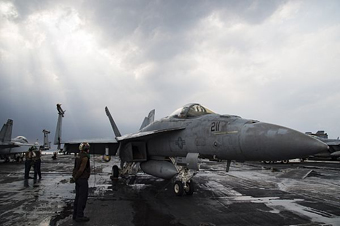
An F18 Super Hornet is prepped for a bombing run in Iraq/Photo courtesy of U.S. Navy
U.S. Military Bombing Increased in 2016
| published January 9, 2017 |
By R. Alan Clanton, Thursday Review editor
During the last full year of the administration of President Barack Obama, the combined forces of the U.S. military dropped or delivered more than 26,100 bombs to targets on the ground—a staggering number historically considering that the United States is not officially at war with any foreign nation.
The vast majority of the bombs were dropped in two theaters of operation—Iraq and Syria—where the U.S. and its coalition allies are engaged in efforts to degrade and destroy the military components of the Islamic State, also known as ISIS or ISIL. Roughly 12,000 bombs were dropped in Iraq, another 12,000 in Syria, with the remaining ordnance used in other countries or regions, including Afghanistan, Libya and Yemen.
The totals come from a report recently compiled and released by the Council on Foreign Relations, which drew its data directly from materials provided by the Pentagon, the White House, several congressional committees charged with monitoring military activity, various think tank data, and a variety of international news and information services. Some of the data also comes from NATO and from U.S. military partners, such as the United Kingdom and Jordan.
The 2016 numbers represent a sharp increase in bombing over 2015, according to the CFR. But the increase also speaks to the intensity of U.S. efforts to push back against ISIS after the Islamic State made substantial and swift territorial gains throughout 2014 and 2015. At its zenith, ISIS controlled a vast swath of territory in the Middle East, including much of northern Syria and northern Iraq right up to the borders with Turkey and Jordan, and substantial footprints in Egypt, Libya, Tunisia and Chad. ISIS also gained the support of other radical Islamist military movements, including insurgent groups in Azerbaijan, Turkmenistan, Tajikistan, Yemen, the Sudan, Niger and Nigeria.
The report may spark consternation and outrage by progressives and anti-war activists who say that U.S. has greatly escalated the violence in the Middle East and dehumanized the military efforts through a dramatic increase in bombing and high altitude engagement, an operational method known as the Obama Doctrine. Critics say that the aerial operations also sharply increase the numbers of civilian casualties and collateral damage.
But the numbers may also serve to bolster the argument by hawks who have suggested that the United States and its allies cannot defeat ISIS without a more substantial increase in boots on the ground; much of the ground fighting has been done using insurgent or paramilitary groups (Kurds, pro-Iranian Shias) and Iraqi or Syrian forces, with U.S. personnel acting only areas behind the front lines. Critics have suggested that this method is producing very slow, uneven results. Currently, the U.S. has about 3,100 troops in Iraq, and an unknown number in Syria.
The Pentagon ordered roughly 23,000 bombs dropped in 2015, meaning that the 2016 totals represent more than a 10% increase in bombing.
The authors and editors of the report admit that the exact totals can never be accurately known, since some bombing missions include only one item of ordnance counted by the Pentagon or NATO as a single bomb strike, while still others are multipronged bombs which include multiple explosions. The report also may underestimate some secret missions—many of them using drones—directed by intelligence agencies such as the CIA. And the CFR information does not reflect the bombing activities of other combatants in the region--Russia, Syria, Jordan, Iraq, Turkey, Israel, to name a few.
The increase in bombing will no doubt play a role in the transition from Obamas presidency to that of incoming commander in chief Donald Trump, as well as Congressional approval of future escalations in aerial activity in both Iraq and Syria.
Related Thursday Review articles:
The F35 Lightning: High Tech Bridge to Cyborg War?; R. Alan Clanton; Thursday Review; August 6, 2016.
Stolen Documents Show How ISIS Recruited; R. Alan Clanton; Thursday Review; April 18, 2016.
